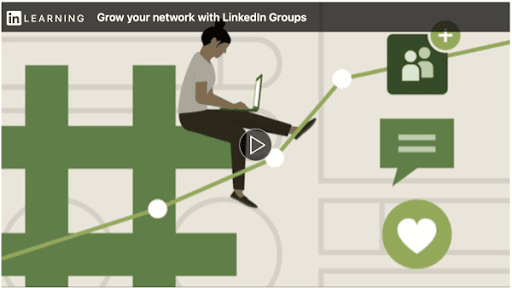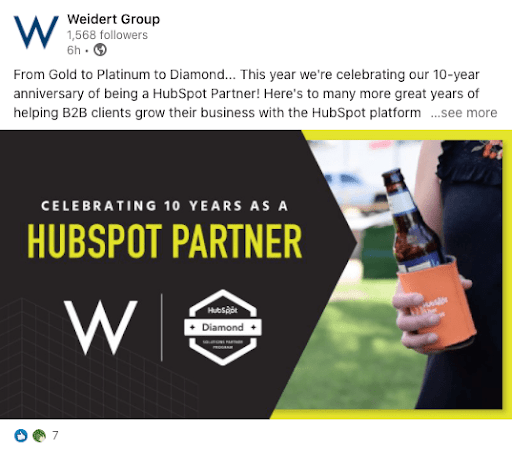Top 10 Tips: How to Get More Connections on LinkedIn
Written by
It’s anticipated that 36.2 million U.S. workers holding professional positions will be remote by the end of 2023, an uptick of nearly 17 million compared to pre-pandemic figures.
An increasingly far-flung workforce has amped up the importance of social networking. So, too, has impressive social selling performance. Nearly 80% of companies engaging in social selling are realizing greater gains than those not implementing it.
With 900 million-plus users in more than 200 countries, LinkedIn is the kingpin platform for B2Bs wanting to interface with prospects, potential hires, business partners, and colleagues.
The popularity and potential has professionals exploring how to get more LinkedIn connections, and whether they’re doing everything they can to enhance their presence.
Even so, learning how to grow a LinkedIn network can be intimidating. Once you’ve exhausted your own contacts list to build your network, it can be tough to know if you’re using the most effective methods of reaching out to create new connections.
These 10 tips provide actionable steps on how to increase the number of connections on LinkedIn and expand your professional network in ways that align with your business goals:
- Polish your profile
- Discern between “follower” and “connection”
- Break down growth goals into achievable chunks
- Be intentional about invitations
- Use the LinkedIn advanced search filters
- Explore LinkedIn Groups
- Post often to encourage engagement
- Increase reach with visual content
- Write and publish articles demonstrating expertise
- Promote your LinkedIn Profile URL
1. Polish your profile
LinkedIn is premised on using very specific search criteria to find prospects, potential hires, and business partners. As much as you rely on the platform to find people, you also want to be found because it’s part of how to get more connections on LinkedIn.
Take the time to fully complete your profile, paying particular attention to the work and education sections. Positions, titles, and educational background can all serve to generate keywords for searching skill sets or professional expertise — and that could lead to business opportunities. You’ll also want to note in your summary or contact settings that you accept invites to encourage more interaction.
RELATED: 12 Tips for Improving Your Manufacturing Sales LinkedIn profile
2. Discern between “follower” and “connection”
LinkedIn draws a clear distinction between “follower” and “connection.” In order to leverage the power of the platform, you should too.
- Following someone on LinkedIn means your page feed will populate with the posts and articles of those you choose to follow. You can read their insights, but cannot interact with the person beyond this one-way communication because you are not officially connected to them
- Connecting with someone on LinkedIn drives more robust engagement and network growth. Sending, receiving, and accepting invitations interconnects people on the platform and enables sharing posts, updates, and messages in two-way communication
LinkedIn assigns levels to each connection to help you better understand the degree of your connectivity:
- 1st degree connections are people you are directly linked to because you mutually completed the invitation process
- 2nd degree connections are people who are not directly connected to you, but are linked to your 1st degree connections. You must send 2nd degree connections an invitation or accept theirs before you can communicate directly
- 3rd degree connections are people who are connected to your second degree connections. Depending on the nature of the relationship, you may want to nurture these connections to bring them closer in your network
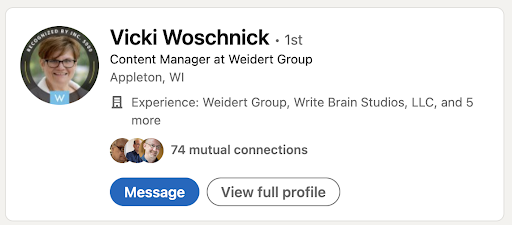
3. Break down growth goals into achievable chunks
Getting from 100 connections to 500+ can seem like an impossible feat if you don’t set realistic expectations about how to grow your network on LinkedIn.
Let’s look at the 100-to-500+ connections objective through a different lens. Instead of all or nothing, divide that number over many weeks or months. Suddenly, the goal doesn’t seem so insurmountable. For example, instead of setting a goal of going from 100 connections to 500+, try setting your goal to 175 connections within two weeks; then repeat.
Remember, the key to setting goals is to make them realistic and time-bound.
Don’t expect all your connection requests to accept your invitations. Some of those you invite may have a personal LinkedIn philosophy of assessing potential quality of connections and deciding whether to accept requests. Here are a few questions I ask myself when I receive a request:
- Do I know you or someone who knows you?
- Am I familiar with your company?
- Do you share industry insights I care about?
- Are you in a geographic market where I do business?
If I can’t answer “yes” to at least one — and preferably more — of these questions, chances are I won’t accept your invitation to connect.
4. Be intentional about invitations
Exercise caution about how to grow connections on LinkedIn. No matter your goals, it’s vital to maintain proper etiquette and refrain from spamming people you don’t know.
To ensure the best quality and quantity of connections, set intentions around your invitations.
Focus on the low-hanging fruit first. Reach out to past and present co-workers, classmates, personal and professional contacts in your email database, and LinkedIn Groups members. Since you are familiar to these people, it will typically result in more invite accepatances. The connections or your new connections will perpetuate growth.
However, don’t give into the temptation to fire off generic requests. Instead, click into the individual’s profile page and click the “connect” button there. That will bring up the box shown below and allow you to add a personal note with your connection request, like “Good to meet you last week in Chicago. Let’s keep in touch.”
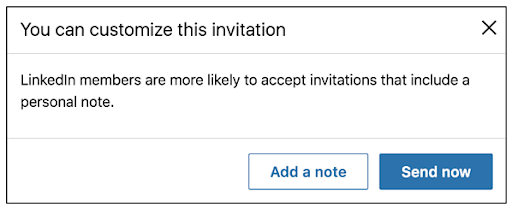
If you’re interested in connecting with someone you don’t know, such as a person who works in a similar role at another company, adding context can go a long way. Before offering an invitation, send an email or InMail message to provide context. You might say, “I’ve seen your posts and noticed some of your work. I really appreciate your perspectives and would love to connect.”
One last piece of advice when it comes to how to grow a network on LinkedIn. Don’t overlook the people you interact with face-to-face on an occasional or routine basis.
Maybe you met someone at a trade show or conference? Volunteer or serve on a committee for a charity event? What about the business owner at your favorite coffee shop, your healthcare provider, yoga instructor, classmates…you get the idea. Reach out! You may be surprised at what you learn about them in the context of LinkedIn.
RELATED: Get Our Complete Guide to Social Media for Complex B2B Industries
5. Use the LinkedIn advanced search filters
The heyday of the dedicated Linkedin Advanced Search page passed in 2017, but that doesn’t mean the functionality disappeared. The search bar is the key. Type in who or what you’re looking for, and a list of results populates, separated into “People,” “Posts,” and “More People” for ease of use.
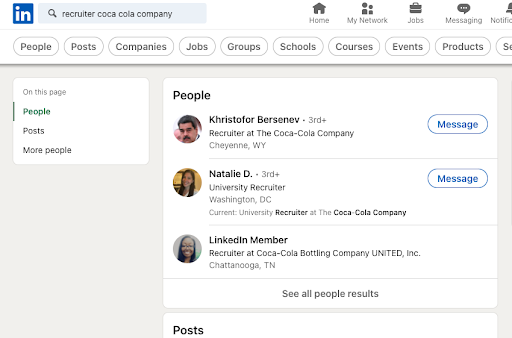
6. Explore LinkedIn Groups
LinkedIn Groups offer topic-specific spaces where you can connect within your industry or specialty to build relationships, share information and expertise, and query communities for advice. You can select groups that reflect communities within your target audiences, both to demonstrate your knowledge and to learn more about prospects and customers. This short video has more details about joining LinkedIn Groups:
Groups are created and moderated by their own leaders and gatekeepers and have their own sets of rules, so be sure to review rules and expectations before requesting to join.
7. Post often to invite engagement
This tip is self-explanatory. When a connection likes, shares, or comments on your status update, their connections are more likely to see your original post in their feed. If your content seems relevant, those 2nd degree connections may take the step to reach out and send an invitation to connect with you.
It’s also a great way to remain engaged with current connections. Frequent publication puts your profile directly in front of their networks, and all it takes is a “like” or comment on their posts. A simple “Great thoughts” or “Thanks for sharing” can help further solidify the connection. Commenting with personal insights or questions adds even more depth and meaning, helping transform connections into relationships.
ALSO READ: Using LinkedIn Career Pages in Your Company Recruitment Marketing
Posting more often creates additional opportunities for engagement, thus syndicating your content across home page feeds everywhere. Don’t be too concerned about annoying people by posting every day. LinkedIn’s algorithms are complex, and your network isn’t likely to see every post — unless you publish an article natively using LinkedIn’s article tool (See Tip 9), which does notify your network.
8. Increase reach with visual content
I’m not just talking about your profile picture and banner image. Posts with images get twice as many views — and research suggests that posts with video content are re-shared 20 times more.
Adding images to your social posts increases engagements with people in your existing network, and boosts exposure to potential connections. So mix it up. Don’t always just share links; include visuals.
9. Write and publish articles demonstrating expertise
It’s common practice to share blog posts that you feel will resonate with your audience by posting an update on LinkedIn with the corresponding URL.
When the insights you wish to share are your own, it’s even more important to put them out in front of people. Publishing articles as native content (also known as long-form posts) on your LinkedIn profile is one of the best ways to establish your personal brand and share your expertise in a given industry.
The great thing about native content is that your network is notified every time you publish an article, increasing your chances of engagement and brand exposure. This also points to the importance of not publishing articles every day, or your followers may start to tune out.
While a simple call-to-action to get in touch or check out additional resources is usually acceptable at the end of the article, nothing will turn off readers faster than an article that ends up being nothing more than click bait or a sales pitch. So only write on topics that truly provide value to readers.
10. Promote your LinkedIn profile URL
Social media platforms such as Twitter and Instagram typically give you space for a bio. Use those bio spaces as a LinkedIn connection-driving machine by encouraging contacts there to find you and connect on LinkedIn, too — especially if you have a significant following on the other platforms.
Don’t be afraid to promote your LinkedIn profile by posting the link in a status update, tweet, pin, video, photo, etc., to take advantage of your presence on other social platforms. Just be sure to claim your public profile so it’s easy to remember and includes important identity information or keywords.
While it’s not a social channel, don’t forget the simplicity and outright importance of adding your LinkedIn profile link to your email signature, like this:
![]()
By the Numbers: Measuring LinkedIn Connectivity
What does a successful LinkedIn profile look like? Statistically speaking, there are connection quantity thresholds that define how well you’re leveraging the platform:
- 500+ connections will generally earn you more blog and website click throughs
- 1,000+ connections will garner you blog and website click throughs, plus an uptick in connection requests
- 5,000+ connections gives you all of the advantages of lower super connector tiers, plus access to LinkedIn Stories — a feature that allows for the creation and upload of a 20-second video that disappears after 24 hours
Getting to 500 or more LinkedIn connections won’t happen overnight, and if you already have 500+ connections, don’t stop there. LinkedIn is the easiest and most powerful networking tool of our time, putting you one quick click away from meeting nearly anyone.
Following these tips should make growing your LinkedIn network less intimidating, more realistic, more productive over time, and ultimately much more fun.
If you’re looking for an even more detailed source of tips on professional networking and engaging with prospects and customers through social media, you won’t want to miss Social Media for Business: A Guide for Complex Industries. Click the link below to get your copy!
Subscribe To Our Blog
Information. Insights. Ideas. Get notified every time a new Weidert Group blog article is published – subscribe now!
You May Also Like...

Artificial Intelligence
Revenue-Driving B2B Content Marketing Strategy with Andy Crestodina

Artificial Intelligence
AI Agents Are Here—How Smart Businesses Are Using Them Now

Inbound Marketing
Podcasting Playbook: What We Learned After 100 Days of Running a B2B Podcast
Accelerate Your Growth with
Weidert Group
If you’re ready to explore a partnership, request a personalized consultation with our team.
